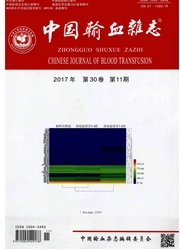

 中文摘要:
中文摘要:
目的建立快速检测献血者中丙型肝炎病毒(hepatitis C virus,HCV)感染的方法。方法利用体外转录制备的HCV RNA转录体进行病毒RNA抽提方法及抽提效率的比较;将RNA转录体与正常血清进行不同数目的混合,对最佳混合标本数进行了摸索;建立HCV荧光定量PCR方法(fluorescence quantitative PCR,FQ—PCR),并对献血者进行混合标本HCV核酸检测。结果确定了比较理想的病毒RNA抽提方法;用于HCV核酸检测的混合标本数为24例;建立的荧光定量PCR方法能最低检测出10个copies/ml;采取24例混合血标本方法,FQ—PCR检测HCV RNA,576例ELISA检测HCV阴性的献血者未检测出HCV RNA。结论初步建立了献血者HCV感染的混合标本荧光定量PCR检测方法。
 英文摘要:
英文摘要:
Objective To establish a rapid screening method for HCV infection in blood donors. Methods In vitro HCV RNA transcripts were prepared and used as the templates to compare the RNA extraction method and efficiency, and also used to search for the optimal number of serum sample pool by mixing with normal serum. Fluorescence quantitative PCR (FQ-PCR) was established and was carried out for the detection of HCV infection among blood donors. Results Optimal extraction method of HCV RNA was identified. Pool sizes chosen for screening of HCV nucleic acid was 24 donations. The lowest detection limit of established FQ-PCR was 10 copies/ ml. None of 576 HCV ELISA negative sera was detectable positive for HCV RNA. Conclusion FQ-PCR screening method is established for HCV RNA detection of pooled samples.
 同期刊论文项目
同期刊论文项目
 同项目期刊论文
同项目期刊论文
 p28(GANK) overexpression accelerates hepatocellular carcinoma invasiveness and metastasis via phosph
p28(GANK) overexpression accelerates hepatocellular carcinoma invasiveness and metastasis via phosph HBx sensitizes cells to oxidative stress-induced apoptosis by accelerating the loss of Mcl-1 protein
HBx sensitizes cells to oxidative stress-induced apoptosis by accelerating the loss of Mcl-1 protein Dysregulation of beta-catenin by hepatitis B virus X protein in HBV-infected human hepatocellular ca
Dysregulation of beta-catenin by hepatitis B virus X protein in HBV-infected human hepatocellular ca Identification of deregulated miRNAs and their targets in hepatitis B virus-associated hepatocellula
Identification of deregulated miRNAs and their targets in hepatitis B virus-associated hepatocellula Association of novel mutations and haplotypes in the preS region of hepatitis B virus with hepatocel
Association of novel mutations and haplotypes in the preS region of hepatitis B virus with hepatocel Nuclear factor high-mobility group box1 mediating the activation of Toll-like receptor 4 signaling i
Nuclear factor high-mobility group box1 mediating the activation of Toll-like receptor 4 signaling i Posthepatectomy HBV Reactivation in Hepatitis B-Related Hepatocellular Carcinoma Influences Postoper
Posthepatectomy HBV Reactivation in Hepatitis B-Related Hepatocellular Carcinoma Influences Postoper A matched case-control study of hepatitis B virus mutations in the preS and core promoter regions as
A matched case-control study of hepatitis B virus mutations in the preS and core promoter regions as Hepatitis B virus X protein enhances cisplatin-induced hepatotoxicity via a mechanism involving degr
Hepatitis B virus X protein enhances cisplatin-induced hepatotoxicity via a mechanism involving degr Inhibition of IRS-1 by hepatitis C virus 2ainfection leads to insulin resistance in a PTEN-dependent
Inhibition of IRS-1 by hepatitis C virus 2ainfection leads to insulin resistance in a PTEN-dependent Two conserved histidines (His490 and His621) on theE2 glycoprotein of hepatitis C virus are critical
Two conserved histidines (His490 and His621) on theE2 glycoprotein of hepatitis C virus are critical Distribution and hepatocellular carcinoma-related viral properties of hepatitis B virus genotypes in
Distribution and hepatocellular carcinoma-related viral properties of hepatitis B virus genotypes in Gankyrin-Mediated Dedifferentiation Facilitates the Tumorigenicity of Rat Hepatocytes and Hepatoma C
Gankyrin-Mediated Dedifferentiation Facilitates the Tumorigenicity of Rat Hepatocytes and Hepatoma C Zinc finger protein ZBTB20 expression is increased in hepatocellular carcinoma and associated with p
Zinc finger protein ZBTB20 expression is increased in hepatocellular carcinoma and associated with p Cyclin G1-mediated epithelial-mesenchymal transition via phosphoinositide 3-kinase/Akt signaling fac
Cyclin G1-mediated epithelial-mesenchymal transition via phosphoinositide 3-kinase/Akt signaling fac Establishment of mouse teratocarcinomas stem cells line and screening genes responsible for malignan
Establishment of mouse teratocarcinomas stem cells line and screening genes responsible for malignan Challenges of incorporating gene expression data to predict HCC prognosis in the age of systems biol
Challenges of incorporating gene expression data to predict HCC prognosis in the age of systems biol Gut-derived lipopolysaccharide promotes T-cell-mediated hepatitis in mice through Toll-like receptor
Gut-derived lipopolysaccharide promotes T-cell-mediated hepatitis in mice through Toll-like receptor 期刊信息
期刊信息
